Green river milestone
July 10, 2014
Improving the Los Angeles River has become a local cause célèbre, with increasing numbers of Angelenos pushing to transform the concrete channel into a place where people can exercise, play and relax.
This Saturday, L.A. County takes a big step toward that goal when it opens the L.A. River Headwaters Project, which is located at the river’s official beginning—the convergence of Calabasas and Bell creeks in Canoga Park.
The $11.5 million project is the river’s largest greenway improvement so far, with 2.5 miles of upgrades that benefit the public and the environment. Cung Nguyen, the river’s watershed manager for the Department of Public Works, said the opening is an important milestone.
“If we improve the beginning and end of the river, then we can start filling in all the gaps,” Nguyen said. “Ultimately, the grand picture is to provide connectivity for recreation along the whole river.”
Joggers and bicyclists will gain access to 2.5 miles of new trails (1¼-mile in each direction) on which to ride and run, passing safely under street crossings and over pedestrian bridges. Rest areas with benches will provide pit stops for those who prefer to take a slower pace.
Native landscaping replaces the former backdrop of an access road and chain link fencing. It also creates new habitat for wildlife, including 300 species of migratory birds that rest their wings by the river. Maintenance crews have been trained to know when nesting seasons are so they won’t disturb the avian guests as they pass through.
The project is still designed to help prevent devastating floods while reducing the amount of urban runoff with bioswales—subsurface plant and sediment-filled structures that let water seep into the ground to be filtered naturally rather than getting fast-tracked, pollutants and all, into the ocean. Nguyen estimated that up to 587,000 gallons of water will be recaptured in an average year.
The headwaters project is funded by the county Flood Control District, along with a $1.8 million grant from Prop. 84, a state initiative dedicated to improving water systems. The project originated with the 1996 L.A. River Master Plan, which recognized the waterway’s importance as a natural resource and targeted publicly-owned lands for future projects. More than 50 of those projects have been completed to date, with another 50 or so to come. Coming up are more greenways like the headwaters project as well as things like wetlands, parks, bike paths and kayaking programs. Just last month, another San Fernando Valley greenway, the half-mile Valleyheart Riverwalk project, opened between Studio City and Sherman Oaks.
While those project-by-project efforts continue, a $1 billion revitalization plan approved by the Army Corps of Engineers in May is expected to drastically improve a sweeping 11-mile section of the river between downtown L.A. and Elysian Park.
But every piece matters; even after the entire river is revitalized, few people will use all 51 miles of it in a single day. The local community of Canoga Park stands to benefit most from the headwaters project, something that Luis Rodriguez, principal of Canoga Park High School, is keenly aware of. His school sits just west of the headwaters. He sees a great educational opportunity for his students, who have been focusing on topics like water conservation and drought-resistant plants in the context of one of California’s most severe water shortages on record.
“For our school it makes a huge difference, but it’s going to revamp the entire community in a positive way,” Rodriguez said. “There’s so much industry in our area, but living spaces where people can have fun? That’s something that is really needed.”
The official opening ceremony takes place at 11 a.m. on Saturday, July 12, at DeSoto Avenue and the Los Angeles River in Canoga Park, 91303.
Posted 7/10/14
Elementary, my dear camper
July 10, 2014
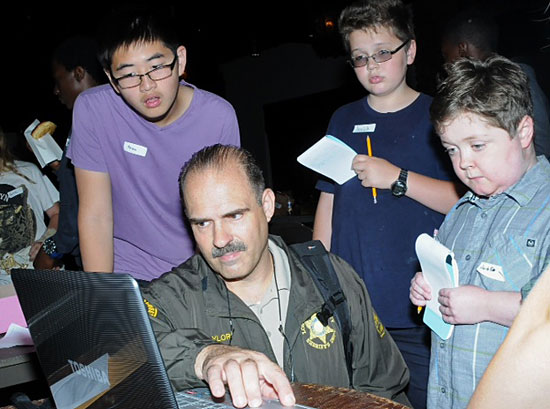
Sheriff's Det. Greg Taylor goes over a mock surveillance video with a group of young campers in June.
It’s been a while since his dad noticed the ad for the summer camp in the local Agoura Hills newspaper. Still, the experience made an impression on Max Bartolomea, now 17.
“It was a murder in a hotel room,” the Oak Park high school senior recalls, chuckling. “The body was gone but the room was still bloody. I loved it—I remember thinking it was exactly how it looked on TV.”
Now in its fifth year, the Los Angeles County Sheriff Department’s Teen C.S.I. Camp, complete with mock crime scenes, has evolved and expanded, but its impact on kids remains.
“It’s fun and they learn a lot,” says Deputy Scott Rule, who devised the camp curriculum in 2009 at the behest of Agoura Hills city officials. Then a member of the Juvenile Intervention Team at the Malibu/Lost Hills Sheriff’s Station, Rule has since taken the show to the sheriff’s Altadena station, where he’s now posted.
“It’s like getting to solve a mystery.”
Los Angeles County has summer diversions aplenty, from art camps at LACMA to nature adventures at the Natural History Museum.
But the sheriff’s Teen C.S.I. Camp has been a sleeper, locally available until now only through the City of Agoura Hills, where municipal officials inspired by crime scene investigation TV shows first floated the idea to the sheriff’s department.
“I actually had one of my own kids go the first year,” recalls Sheriff’s Lt. Jim Royal. “They did a mock murder. There was a preliminary lecture on technique, and then they did forensics—we had our print person come out, and the kids got to take notes and try to figure out who did it. After that first session, it was standing room only. It was a really great idea.”
Since then, sheriff’s officials say, the 5-day camp has steadily added features, though it always revolves around a single “crime.”
“That first year, we did a homicide in a party setting,” recalls Rule. “We used a mannequin for a victim and set it up in a room at a park that the city rented for parties. The murder weapon was an alcohol bottle.
“But we’ve done all sorts of things—one year we had a shooting victim, another year we had a stabbing. Once I even had a bar fight with a pool cue as a weapon. This summer in Altadena, it was a baseball bat.”
Each crime scene, he says, is carefully seeded with clues, from fingerprints to footprints to footage from security cameras. Then the campers, who range in age from 11 to 16, try to deduce whodunnit.
“We don’t make it graphic,” adds Rule, noting that the “victims” are rarely female and never children.
“We want it to be easy and solvable, not gory and bloody. We use plastic knives and the one year we did a gunshot victim, we used a plastic training gun. But every one of those cases are like scenes our detectives have been on—murder scenes, assault scenes, thefts, burglaries.”
The aim, he says, is to put forth a positive image for the department and to engage adolescents with technology that intrigues them (polygraphs, he says, are a guaranteed crowd pleaser.)
But, he adds, the camp also introduces teens to the range of potential careers in law enforcement, from crime lab work to prosecutions.
“I always try to find a local attorney to come out and play the District Attorney, so the kids can present their case and see what kind of charges they can get.”
This is the first year the camp has been offered at the Altadena station, Rule says. A $75 June session drew 23 youngsters—enough to prompt the addition of a second session from August 4-8. (For more information, click here.)
Meanwhile, in Malibu, sheriff’s officials say they had to tweak the curriculum slightly because the local forensic specialists who usually help guide campers were so occupied with real crime that they couldn’t participate without an overtime budget.
Instead of a C.S.I. Camp, the sheriff’s offering will be called “Secret Agent Camp” this year. The camp will run from August 11-14, and will be available through the City of Agoura Hills for $74. (Details are here.)
“We have our own fingerprint [technician] who works here already, and I supervised the crime lab for years, so we will still have a forensic element—it just won’t be as technical,” says Malibu/Lost Hills Lt. David Thompson.
Deputy Alicia Kohno, who has succeeded Rule, promises that the camp will still include all the usual, popular features—a murder, a crime scene, fingerprints, footprints, lie detectors.
Good, says Bartolomea.
Though the teen never aspired to a career in law enforcement—according to his mother, he’s headed later this summer to a USC program for potential medical students—one of his favorite things about the camp was its taste of serious police work.
“I remember thinking that it was really cool,” he says. “And really real.”
Posted 7/10/14
Not just a drop in the bucket
July 9, 2014
When it comes to quenching the water needs of a thirsty region, seemingly modest or far-flung efforts can come together to make quite a splash.
Witness a dozen local projects, from Agoura Hills to south Gardena, that just received an infusion of state grant funding totaling $23.4 million. Each initiative has a singular focus—creating bigger and better groundwater supplies in Pacoima, for instance, or installing curb screens in Calabasas to keep debris from flowing from city streets to the ocean.
But collectively, these endeavors add up to something greater than the sum of their parts: an integrated approach as diverse agencies come together to advance the kinds of water projects that will do the most good across the region.
As California’s drought makes headlines and prompts consideration of mandatory conservation measures, several of the projects have an extremely timely aim: retaining as much stormwater as possible to boost the region’s drinking water supply. Others focus on improving water quality, while some combine water initiatives with community recreation and beautification efforts.
Together, they’re the wave of the future, as the Los Angeles region looks beyond its Mulholland-era history and imagines a new approach to the next 100 years.
“It’s a new paradigm, a paradigm of cooperation and collaboration,” said Mark Pestrella, chief deputy director of the county’s Department of Public Works, which is overseeing the grant projects as leader of the Integrated Regional Water Management coalition in greater Los Angeles.
“There are 500 small water agencies in L.A. County alone, and probably six major water agencies, all talking to each other, reaching out to the communities that we serve and identifying projects that have the biggest community benefit,” Pestrella said.
The $23.4 million in Prop. 84 grant funding that was formally accepted by the Board of Supervisors this week is just one such infusion over the past decade. Since the collaborative water management model went into effect in California in 2002, nearly $100 million has been awarded to water resource agencies in the county, Public Works Director Gail Farber said. The state grant funds, she added, “go a long way towards ensuring a more sustainable water future for L.A. County.”
The endeavors awarded the grant funds approved this week include:
- The Pacoima Spreading Grounds Improvement Project, where new and updated equipment and improved stormwater storage will yield enough new drinking water to supply 42,000 Los Angeles residents for a year. Plans also are under consideration to create a park or open space on the grounds of an adjacent channel.
- Development of a second phase of Marsh Park in the Elysian Valley neighborhood near the L.A. River. The new design will convert industrial land into an open space park that also happens to collect and treat stormwater.
- Restoration of a 34-acre “flood retention basin” in the Upper Malibu Creek Watershed area.
- Design and construction of a 1¼-mile recycled water pipeline in south Gardena.
And, with California’s drought front and center, more help may be on the way soon. The state later this month is expected to issue a new round of grant funding devoted exclusively to drought-fighting projects.
An ambitious slate of 14 L.A. County projects seeking more than $28.8 million in funding has been submitted, with an emphasis on water recycling and replenishing groundwater. The overall goal of the drought-related projects is building the local water supply and reducing dependence on imports.
Posted 7/9/14
New LACMA design spans Wilshire
July 3, 2014
Two Los Angeles County museums’ unique but conflicting visions for the future were enough to send an internationally renowned architect back to the drawing board—literally. Now, after a collaborative process that included exploring the grounds of the La Brea Tar Pits with scientists, architect Peter Zumthor is back with a bold new approach for a signature building at the Los Angeles County Museum of Art that avoids the famed Ice Age fossil trove and instead creates a dramatic bridge across Wilshire Boulevard.
Zumthor’s new design for the most part preserves his original concept: a largely transparent building with a shape reminiscent of a curvaceous tar pit. But instead of constructing the entire 400,000-square-foot building on the Hancock Park campus that LACMA shares with the tar pits, he now proposes having one quarter of the structure reach south across Wilshire to what’s currently the museum’s Spaulding Avenue parking lot. One of the new building’s five distinctive glass pavilions—through which passersby will be able to see the museum’s art—would now be located on the south side of the boulevard.
A model of Zumthor’s original plan for the building was displayed last spring as part of a LACMA exhibit intended to inspire public conversation about the project. But Topic No. 1 in that conversation quickly became Natural History Museum officials’ concern that the proposed structure could obstruct future scientific discoveries hidden in the rich subterranean world of micro-fossils.
In the face of such worries, officials of both museums appeared before the Board of Supervisors last September and pledged to work together to preserve the tar pits while creating a new building that would replace several aging structures on the LACMA campus.
The current design, which still must obtain a range of environmental and governmental approvals in order to go forward, grew out of that process.
“Necessity is the mother of invention,” said Supervisor Zev Yaroslavsky, who has directed county funding to a feasibility study of the project that is now underway. The new design “is actually more iconic than his original design. It’s a win-win.”
“We think the design is much better,” agreed Michael Govan, LACMA’s director and CEO. He said the new approach opens up more park space around the tar pits, creates better vistas on a “continuous veranda” around the building and makes a more compelling visual statement by bridging Wilshire.
“It really becomes a landmark,” Govan said.
Zumthor had originally intended the design to be a “love letter to the tar pits,” but as criticism emerged about its possible negative impact on science at the site, he “joked that the tar pits didn’t love it back,” Govan said.
Well, that loving feeling appears to have returned.
“I think the results show that we all worked in good faith to both provide LACMA with an exciting building and to protect and preserve the tar pits,” said NHM director and president Jane Pisano, who walked the site with Zumthor and her team of scientists in February. “It was a chance to really talk to the person who had the challenge of coming up with the solution. I have to say, I was just very impressed by what a good listener he is.”
Museum officials have previously said that it will take a $650 million campaign to bankroll all elements of creating the new building. An updated figure, taking into account a potentially more complicated construction process, will not be available until the feasibility study is completed in the spring.
Meanwhile, though, the collaboration between the two county museums already is paying dividends.
“I personally have had a lot of fun getting to know in more depth the science of the La Brea Tar Pits,” Govan said.
As for Pisano, she said she always felt a good solution eventually would emerge.
“One of the things that I knew for sure was that architects, particularly good architects, thrive when they’re given very difficult design challenges,” Pisano said. “And I think that both the thriving and the design challenges were present in this case.”
Posted 6/24/14
L.A.’s free summer soundtrack
July 3, 2014
From Balinese gamelan music to mariachi spectaculars, jazzy interludes to multicultural pop, Los Angeles County is about to start grooving to the summertime beat of free music.
Nearly 60 free concerts are scheduled this season at parks and other public venues throughout Los Angeles County. Funded by the Board of Supervisors and sponsored by the county Arts Commission, the performances promise an incredible diversity of musical genres that give new meaning to the refrain “hot town, summer in the city.” Artists for just this month alone include Hound Dog Dave and the Mel-Tones, the UnderCover Girls, Samba Society and Julio Montero and the Far South Trio. The lineup of concerts in the 3rd District is here, featuring performances at El Cariso Regional Park, the Los Angeles County Museum of Art, Kings Road Park in West Hollywood and San Fernando Recreation Park. A schedule of what’s going on countywide is here.
And because this is Southern California, there’s an added bonus: the music doesn’t have to stop till October 19, when the Mariachi Divas bring down the curtain on the summer free concert season at Heritage Plaza Park in Covina.
Posted 7/3/14
Picking up pace to protect kids
July 3, 2014
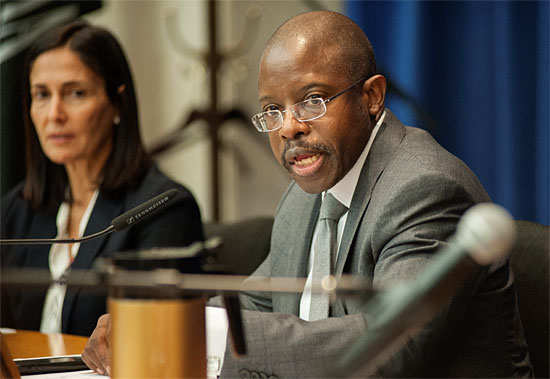
David Sanders and Leslie Gilbert-Lurie are moving from the blue ribbon panel to a new transition team.
As Los Angeles County prepares to hire its first-ever child protection czar to lead an ambitious new oversight program, efforts to build that system accelerated this week with the appointment of a high-profile transition team to help get the initiative off the ground.
The nine-member team approved by the Board of Supervisors on Tuesday includes a mix of newcomers as well as several veterans of the Blue Ribbon Commission on Child Protection, which earlier this year urged the county to create an Office of Child Protection as the cornerstone of a wide-ranging package of reforms.
The transition team is charged with sifting through more than 40 of the commission’s recommendations to help prioritize which the county should implement first.
David Sanders, who chaired the blue ribbon panel and also will be a member of the transition team, said a big part of the interim group’s job will be to make sure that proposed reforms receive the necessary follow-through.
“We really have concerns about that…We didn’t want to just add a new series of recommendations,” said Sanders, a former head of the county’s Department of Children and Family Services who now is an executive vice president of the Seattle-based Casey Family Programs.
The team, which is meant to disband once the Office of Child Protection is up and running, will also help recruit and shape the job description for the person who will run the new agency.
In addition, the transition panel is charged with making some critical assessments in the days and weeks ahead. For one thing, it will evaluate the performance—and potential for expansion—of the county’s network of so-called medical hubs, where the physical health of youngsters coming into the system is evaluated. And it will wade into the sometimes contentious issue of how best to use county nurses to help social workers conduct frontline investigations of suspected child abuse.
The transition team will provide monthly updates to the Board of Supervisors beginning on August 5.
The reforms now being implemented come after the horrific death last year of Gabriel Fernandez, an 8-year-old Palmdale boy was left by social workers in the care of his mother and her boyfriend despite multiple reports of abuse, neglect and torture.
Even before the blue ribbon commission began its work, current DCFS head Philip Browning had embarked on a reform mission from within the department, including expanded training, a plan to hire more staff and reduce caseloads, creation of a foster care search engine, and a new data-driven approach to making the agency function more effectively. Those efforts continue as the transition team’s work gets underway.
In addition to Sanders, transition team members who also served on the blue ribbon commission include Andrea Rich, Leslie Gilbert-Lurie and Janet Teague.
The newcomers include Dr. Mitchell Katz, the county’s director of Health of Services, along with former Los Angeles County District Attorney Steve Cooley, Supervising Dependency Court Judge Margaret Henry, Patricia Curry of the county Commission on Children and Families and Antonia Jimenez of the county’s Chief Executive Office.
Sanders said the group represents a rich mix of professional knowledge and L.A. County experience.
“I couldn’t be more excited,” he said. “I think it’s really a remarkable team.”
Posted 7/3/14
A diversion from the status quo
July 3, 2014
When it comes to Los Angeles County’s decrepit Men’s Central Jail, building a better future doesn’t have to mean spending $2 billion to erect a replacement structure that would continue to house huge numbers of mentally ill inmates accused of low-level, non-violent crimes.
Two months ago, as the only member of the Board of Supervisors to vote against moving forward on this massive, publicly-financed construction plan, I argued that we must first fully investigate the opportunities for diverting low-risk members of this population into community-based treatment programs.
My reasoning was simple: if we can find more humane and effective treatment outside jail cells for these mentally ill individuals, then we might be able to scale back the size and cost of the proposed new downtown jail. At the same time, we might also be able to make our neighborhoods safer by reducing the high rate of recidivism typically associated with mentally ill offenders. They stand little chance of achieving lasting recovery inside an oppressive and teeming jail environment where they have been chained to tables during therapy sessions and victimized not only by fellow inmates but by some sheriff’s deputies who run the operation.
This week, the American Civil Liberties Union of Southern California released a persuasive new report that should serve as yet another reminder of why we must confront this issue now, before we commit another dollar to a construction project that, while well intentioned, will continue to give our county the ignominious distinction of overseeing the biggest mental hospital in the nation.
The report, produced in conjunction with the Bazelon Center for Mental Health Law, cites examples from around the country, where recidivism and incarceration costs have been slashed through jail diversion programs. One, in New York, reported a 70% reduction in arrests among participants during a two-year period, according to the report. A diversion program in Miami-Dade County, meanwhile, reduced recidivism among misdemeanor offenders from 75% to 20%.
The report also notes that, once an individual is placed in a community-based setting, federal and state funds can be tapped to help finance the treatment, which can’t be done as long as a person remains behind county bars.
Among the leadership of the Sheriff’s Department, there’s a belief that only a new 5,000 bed mental health jail will satisfy the U.S. Department of Justice, which has been monitoring the county’s treatment of mentally ill inmates for more than a decade, ever since concluding that their constitutional rights were being violated. Last month, the DOJ didn’t pull punches when it informed us that, despite improvements, serious problems remain in preventing inmate suicides. The justice department lawyers warned that they’re now prepared to step up the oversight by seeking the intervention of the federal courts.
It seems clear to me from the tenor of that 36-page letter that the Justice Department expects improvements now, not in 10 years, when the proposed new jail would be scheduled for completion. In fact, the DOJ lawyers praised a Board of Supervisors vote to analyze diversion programs and said “we strongly encourage the Sheriff, the Mental Health Director, and the County to consider alternatives to incarceration” for mentally ill inmates.
Finally, for those of you who might be inclined to dismiss the ACLU report as a predictably liberal position, I’d point out that the leading champion of community-based diversion programs is Los Angeles’ top prosecutor, Dist. Atty. Jackie Lacey. During testimony before the Board of Supervisors on the day of the jail construction vote, she suggested that as many as 1,000 inmates may be needlessly held behind county bars. “The current system is, simply put, unjust,” Lacey said bluntly.
And that can’t be made right by embarking on the biggest capital-spending project in Los Angeles history. This issue, with the stakes so high, requires a level of intellectual capital that we’re only now starting to expend.
Posted 7/3/14
Bursting in air o’er Grand Park
July 2, 2014
There was a time when fireworks on the roof of the Dorothy Chandler Pavilion would have been as hard to imagine as a crown of sparklers on the head of its namesake philanthropist/socialite.
The Dorothy Chandler was the stateliest spot in one of the stateliest cultural centers in the country, surrounded by high rises and imposing government buildings. And downtown was a place that many Angelenos went for work, if they went there at all—not a prime destination for frolicking in a park.
Talk about changing times.
Last year, some 10,000 showed up at Grand Park for its first Fourth of July party, so many that organizers thought it was a fluke until 20,000 arrived for New Year’s Eve.
Now, armed with lessons learned since the park opened in 2012 as an instant L.A. icon, park officials are replacing old rules with a growing playbook of downtown event planning. On the horizon: Everything from more ambitious community gatherings to a two-day Budweiser Made in America event on Labor Day weekend, featuring John Mayer, Steve Aoki and, possibly, Jay Z (park officials say he hasn’t confirmed yet).
This Fourth of July, Grand Park programmers are anticipating some 25,000 people, and are preparing a downtown perimeter to potentially handle twice that many. Two live bands—one soul, one indie—will provide music, twice the entertainment provided last year. No alcohol will be allowed in the park (bags will be checked.) But there will be more food trucks, more security and, thankfully, more bathrooms. Organizers have even lined up a free bike valet to help park your ride.
Most striking, though, will be the changes in the pyrotechnics.
“Last year, we shot off the fireworks in the middle of the park, which meant we forfeited some of the real estate that people could have used to gather,” says Julia Diamond, Grand Park’s programming director.
This time, she says, the fireworks will come from the roof of the Dorothy Chandler, where programmers turned in an effort to save space and maximize visibility for the park’s farflung neighbors.
“We’re recognizing that these park events aren’t just park events, they’re becoming L.A. events,” Diamond says. “This year, the show will be visible from Boyle Heights, parts of Echo Park, Elysian Park—all over. People will not only have the option to come to the park, but they’ll also be able to watch from home if they want and still have a celebration. And this will give us flexibility to shoot off more and bigger fireworks than we’ve done before.”
The move reflects no small measure of ambition. Last year’s Fourth of July spectacle was impressive, but because the fireworks were launched from ground level, they were more like the stage pyrotechnics at a rock concert than the traditional Independence Day overhead extravaganza.
According to Los Angeles City Fire Inspector Ben Flores, the fire marshal for the Grand Park celebration, the traditional type of show is possible only with the use of projectiles that explode hundreds of feet in the air and require hundreds of feet of clearance so that onlookers aren’t singed by the burning, pressed-wood shells that fall in the wake of the starburst.
Past attempts at urban projectile-style fireworks downtown have had mixed results.
In 2006, for instance, a fireworks display at a black tie gala ignited a small blaze when one of the projectiles accidently flew into a ninth floor window at Los Angeles City Hall.
“Luckily, a sprinkler head was right there,” recalls Flores. “It didn’t so much burn as set off the sprinklers and cause water damage.”
Nonetheless, Diamond says, the experience was sobering enough for city firefighters that no one at the park even suggested City Hall as a staging area for this year’s fireworks.
Because Grand Park is technically part of the Music Center, the Dorothy Chandler Pavilion loomed as the obvious venue.
“We installed new security railings to ensure the production team will be safe,” Diamond says. “And we’ll be using water to hose down part of the Music Center Plaza to make doubly sure there’s no damage.”
The roof itself, she says, is already fireproof. And the location is ideal because the Music Center complex is at the top of Bunker Hill, about 100 feet above the elevation of City Hall.
Diamond says security crews will begin clearing crowds long before the 9 p.m. start time of the fireworks show to ensure that the area around the Music Center is safe and clear for viewing.
And the fireworks’ change of venue should provide plenty of Instagram-ready moments.
“The Department of Water and Power will be right there, which is also an iconic backdrop,” says Diamond. “It’s going to be beautiful.”
Grand Park’s 4th of July Block Party will be held from 4-9 p.m. at 200 N. Grand Ave. in Downtown Los Angeles. The event perimeter will extend from Temple to Second Streets between N. Grand Avenue and N. Spring Street. Doors open at 1 p.m. Music starts at 4 p.m. Fireworks are at 9 p.m.
Posted 7/2/14




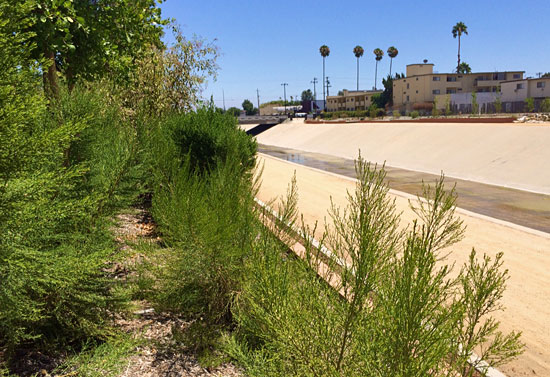
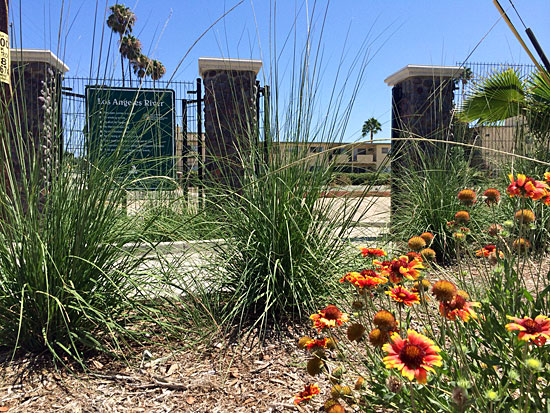
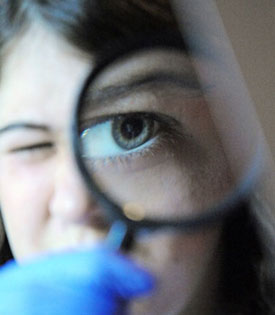
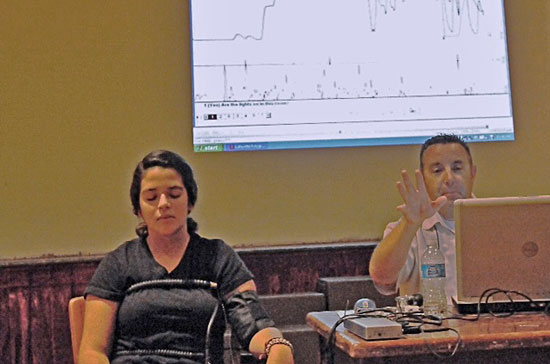
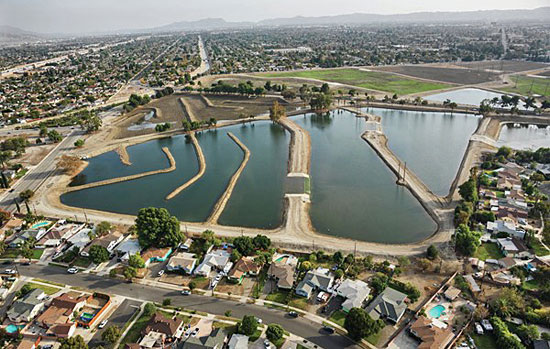

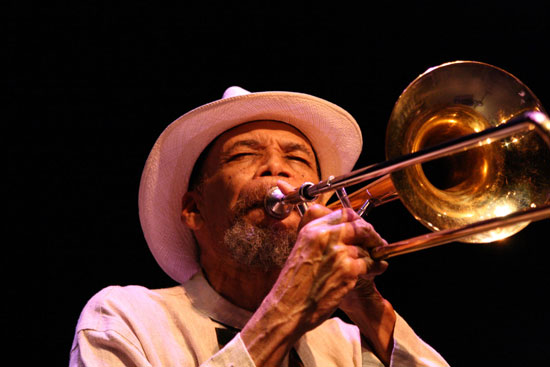
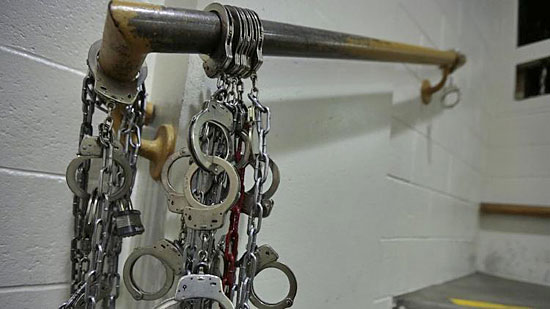
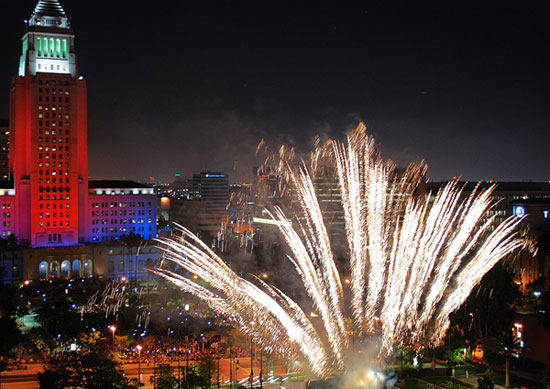
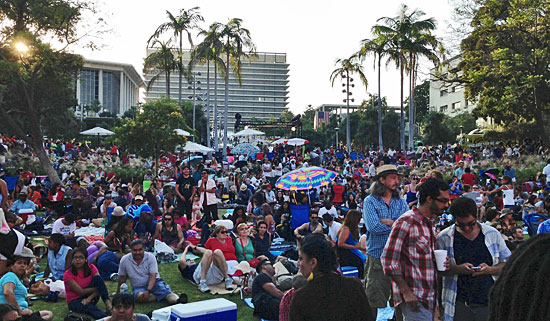





 Check for the latest closure information
Check for the latest closure information








